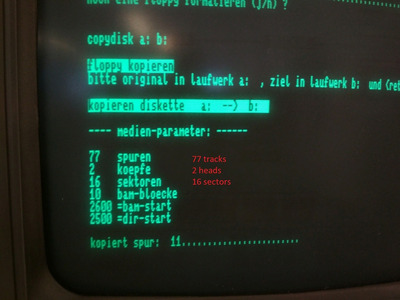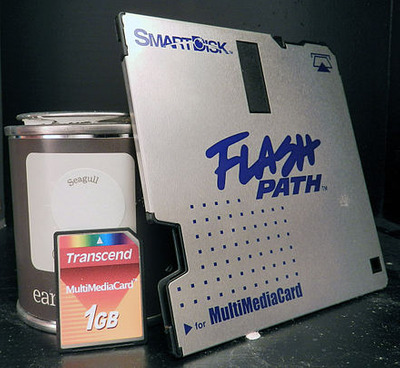Is this thing from former East Germany, by any chance? If so, the eastern-style drive technology would make sense.
I'm wondering, because it uses language that I would expect from GDR. Because, it's too German.
"vollgrafik" is written with a "k", which fits for eastern German, for example.
Back then, West Germany still widely used the old spelling, so it would read -> "vollgraphik".
Similar word differences : Telefon vs Telephon, Elefant vs Elephant, Delfin vs Delphin, Telegraf vs Telegraph
Also, the term "laden" (it reads "DOS laden"..
In Western German, it would rater say "DOS starten" or "DOS booten".
All in all, the language reminds me a bit of the DCP operating system.
Anyway, it's just a wild guess. Perhaps it's really from West Germany.
Edit: If it's possible to run a DOS program on this machine without the need to modify the original floppies (use a copy instead) :
The program Disc Copy Fast can duplicate floppies, but also can write into an image file.
So it might be possible to dump the control software into a floppy image.
Provided that the floppy image can be stored on something that's accessible later on.
https://m.youtube.com/watch?v=0zEVBO84afk
Hm. Is a serial port available on the device by any chance?
If so, DCF could write the image to a remote drive on another PC.
Needed would be a null-modem and a DOS driver.
Re: 386 , what can I do with it?
Edit: If a floppy image file (use compressed image?) can fit on one of the diskettes..
It's possible to dump the boot diskette in A: to a floppy image located on a floppy in drive B:.
After the file is created, it could be sent via serial port of parallel port (LapLink).
For serial connection, a DOS terminal program could be used for sending the image file.
Or a simple KERMIT program could be typed in via debug program.
Or, the COPY command could be tried. Something like: COPY /B DSK.IMG > AUX
On the reception side, same in reverse. Ctrl-C for abortion.
Assuming that this OS is DOS compatible.
Or, use DDLink: Re: DDLINK: Easily move files between/To/From DOS systems
Edit: The default Gotek firmware is unreliable, in my opinion.
Flash Floppy is a free alternative, with support for non-standard floppy images.
Edit: MS-DOS and PC-DOS before 1987 didn't support 1,44 MB format.
It was introduced in PC-DOS 3.30, I vaguely remember.
Also, PC/XT technology didn't support 1,44 MB format yet, due to the slow floppy controller.
Normally, XTs used a 250KB/s floppy controller, unless updated.
PC/AT use a 500KB/s floppy controller (high-speed) by default.
That doesn't mean that 1,44 MB drives can't be used, however. They can be used as substitutes for 720 KB types.
Ideally, they're operated with HD media, though.
So it made sense that HD floppies with the covered hole were used.
HD floppy+HD drive is fine, no matter the formatted capacity. 360KB formatting would fine, too.
A DD floppy can also be used read-only, just fine. If it was being written to by a DD drive, originally.
Problems merely occur, if the wrong drive/media was involved in a write operation.
Edit: Another thought: If the Gotek can be physically installed as an 1:1 replacement,
it might be possible to just use the built-in copydisk utility.
A replacement firmware like Flash Floppy or HxC can support a variety of floppy formats just fine.
If it works, this would perhaps be the most straightforward and clean solution.
Edit: Another idea, use a floppy disk emulator (not floppy drive emulator).
Source: https://en.wikipedia.org/wiki/FlashPath
If you're lucky, these old fake floppies with MMC or Smart Media slot can simulate a a real floppy disk well enough.
Then, you can try to dump the data of the flash card. Make an image with Win32DiskImager and extract the floppy data with a HexEditor or WinImage.
Edit: Another idea. The XTIDE Universal BIOS (XUB) has a serial boot feature.
If it's somehow possible to get XUB into the system, a hard disk can be simulated on a remote PC.
XUB has an optional utility that simulates HDD. Just don't forget to run the config program, because the XUB binary must be configured once before first use.
Anyway, it's just an idea, assumed that the device is based on regular PC technology.
Edit: Another idea, but it's a far fetch.
Use a Windows 2000 or XP with a real floppy drive controller and a matching drive.
Then install OmniFlop floppy replacement driver and use Emulator Explorer.
http://www.shlock.co.uk/Utils/OmniFlop/OmniFlop.htm
http://www.emulators.com/explorer.htm
Edit: Another idea. You need two floppy drives, a blank floppy and a DOS PC, though.
This hack might work better with non-standard floppy drive speeds than OmniFlop.
http://www.oldskool.org/disk2fdi/trial.html
https://www.youtube.com/watch?v=GOp-_Tmo4TE


